Some of the mushrooms that stand out the most are yellow. Found around the world, they can be edible or toxic, so correct species identification is a must.
Some yellow mushrooms are very rare and may not be found outside deep moist woodlands. Others are more common and even readily available in stores.
Local cultures also influence the names of these mushrooms. Sometimes differently named, they grow from spring to early winter, depending on their region.
Many yellow mushrooms have a mycorrhizal associated with oak, pine, or other trees which means they mostly grow in woodlands.
The following mushrooms have widespread distribution. They may be edible, toxic, or even deadly in some cases. Here’s how to identify them, where to find them, and their edibility status.
Table of Contents
1. Honey Mushroom
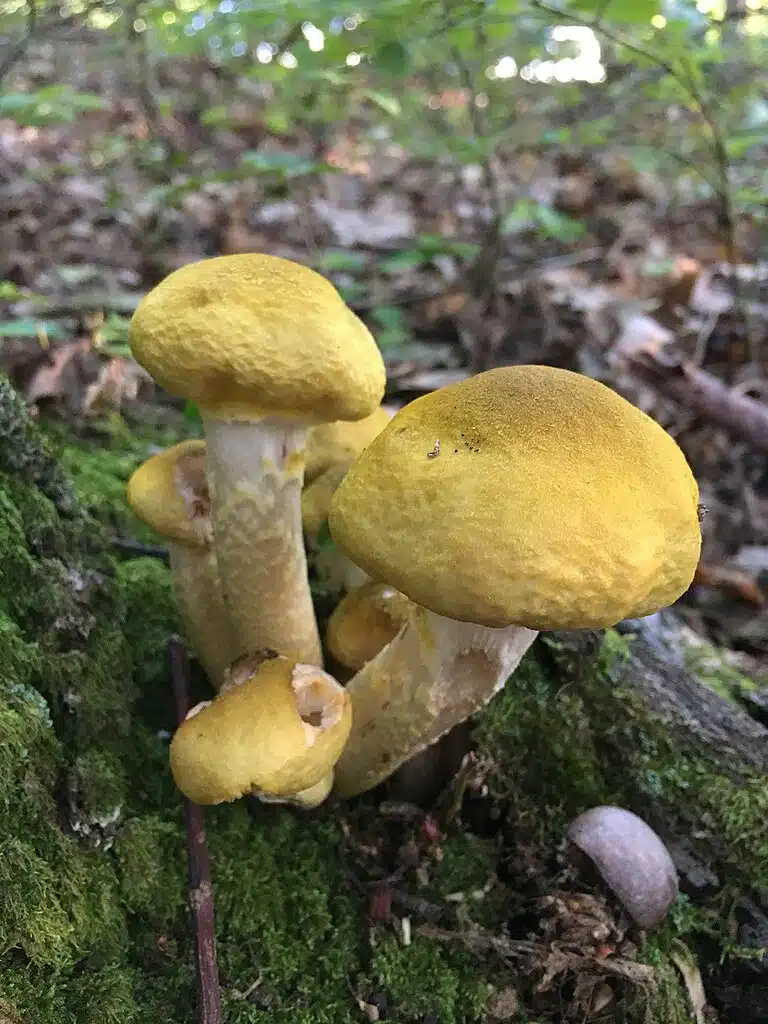
Scientific name: Armillaria mellea
Common name: Honey Mushroom, Honey Fungus, Stumpie
A species of The Northern Hemisphere, Honey Mushrooms grow on hardwoods. Mostly identified by their yellow-golden nuance, Yellow Mushrooms grow both on live and dead hardwood.
The presence of these mushrooms in Europe and North America is considered invasive. Their parasitic growing pattern is a concern when planting new trees.
Some of the signs of Honey Mushrooms include spotting their rhizomorphs on the base of trees or even on the upper tree trunk.
Honey Mushrooms may be seen as edible in some regions of the world. Some people don’t like their taste while others go as far as reporting feeling ill when eating them.
Those that do eat them typically only cook Honey Mushroom caps.
2. Mica Cap
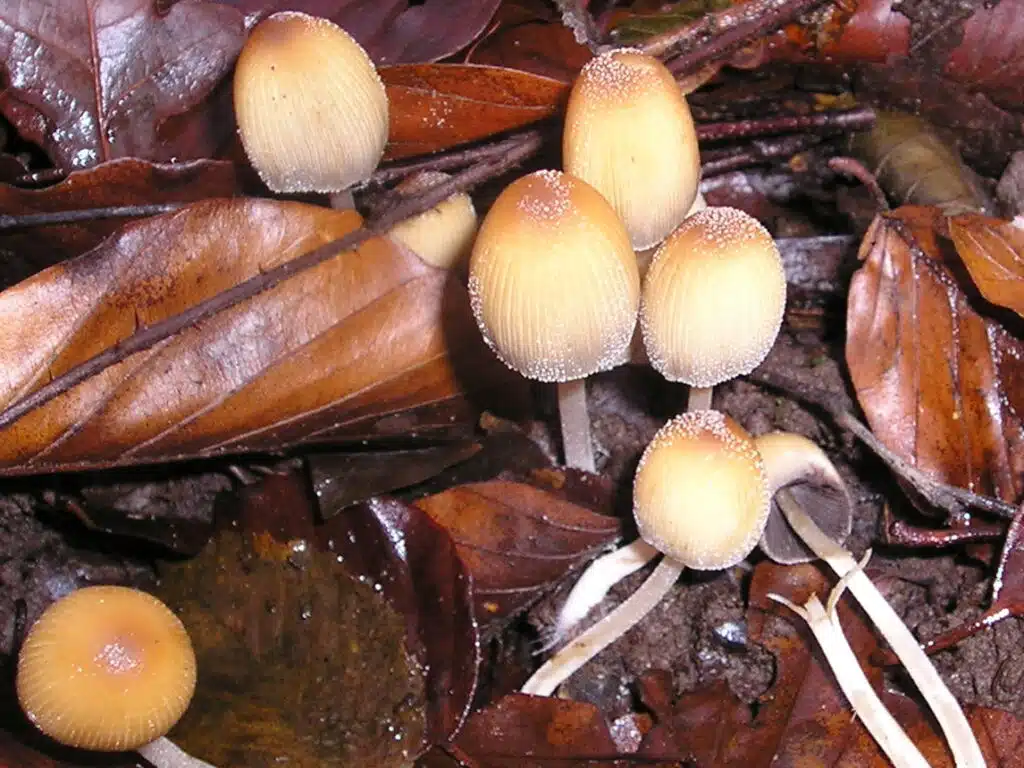
Scientific name: Coprinellus micaceus
Common name: Mica Cap, Shiny Cap
Mica Caps grow on decaying vegetation. They grow on decaying bark and roots.
The number of Mica Cap fungi growing in groups is variable. From a few to tens of fungi, they can cover dead wood over time.
Mushrooms of the species have a large cap and a thin tall stipe.
They feature a yellow-tan nuance which darkens to tan-brown as they grow.
As for size, Mica Caps are variable as well. When fully grown, they reach a variable height of 0.7 to 2 inches.
Mushrooms of this species can be spotted almost throughout the year, sometimes even in the winter.
3. Yellow Patches
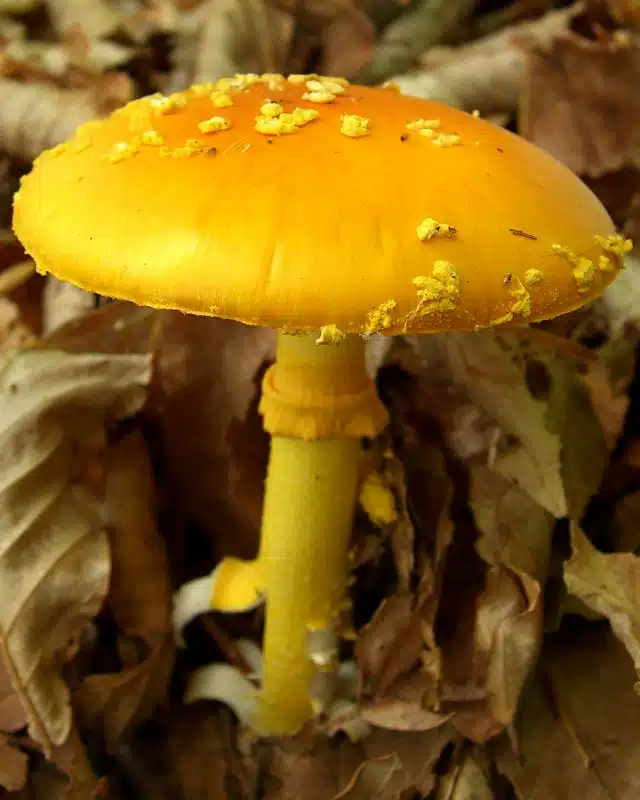
Scientific name: Amanita flavoconia
Common name: Yellow Patches, Yellow Wart
A dark yellow stipe is specific to Yellow Patches. Throughout their growth stages.
Changing colors are specific to Yellow Patches as they grow, but the stipe remains yellow.
A deep orange cap is specific to the species but this cap looks completely different in the first days when it’s covered in yellow warts.
These warts eventually disappear, making way for a smooth orange or orange-red cap.
When it comes to the shape of the cap, it also changes over time, becoming flatter.
The bright yellow caps of the species become even more visible as the cap flattens out.
4. Sulphur Tuft
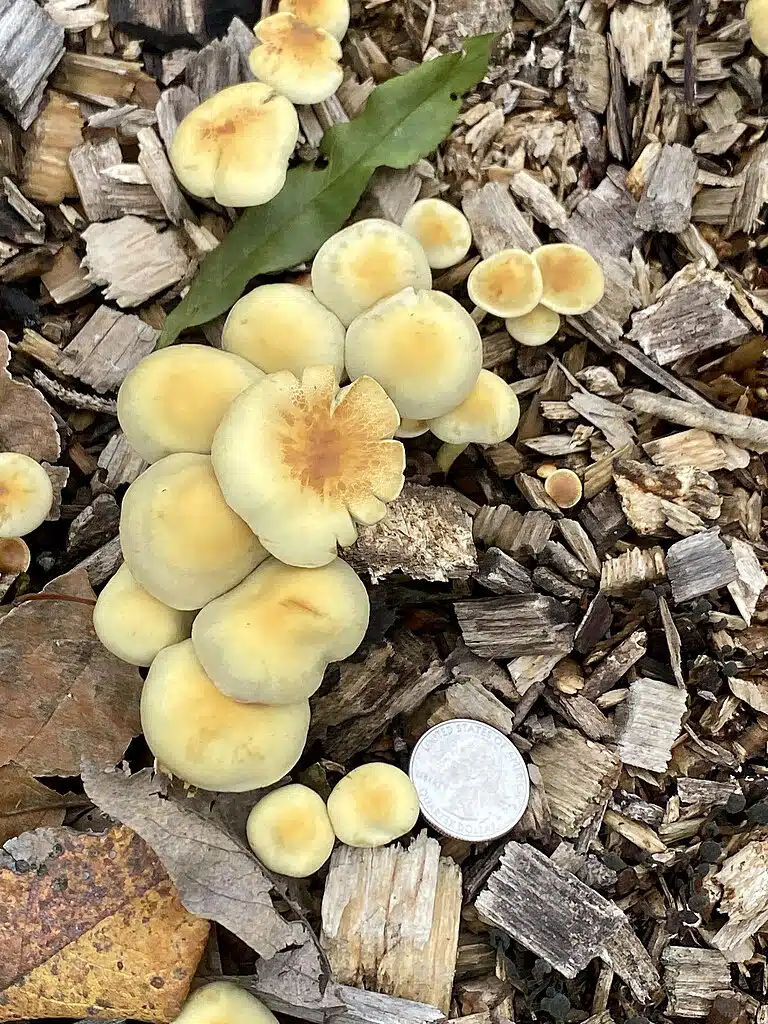
Scientific name: Hypholoma fasciculare
Common name: Sulphur Tuft, Clustered Woodlover
Initially, all-yellow, Sulphur Tuft mushrooms become partially yellow as they grow.
This is a species that shows a darker yellow cap and green gills. An initial yellow color is specific to its gills.
The stipe also shows a combination of green and yellow patterns.
Sulphur Tufts are mushrooms humans should stay away from given their toxicity.
It may take a few hours for these mushrooms to show their extreme reactions, but these include convulsions.
Growing on decaying wood, this species of mushroom typically prefers large clusters so incorrectly identifying it is not common.
Once grown, a Sulphur Tuft reaches a cap diameter of around 2 inches and grows in groups of up to 20.
5. Flowerpot Parasol
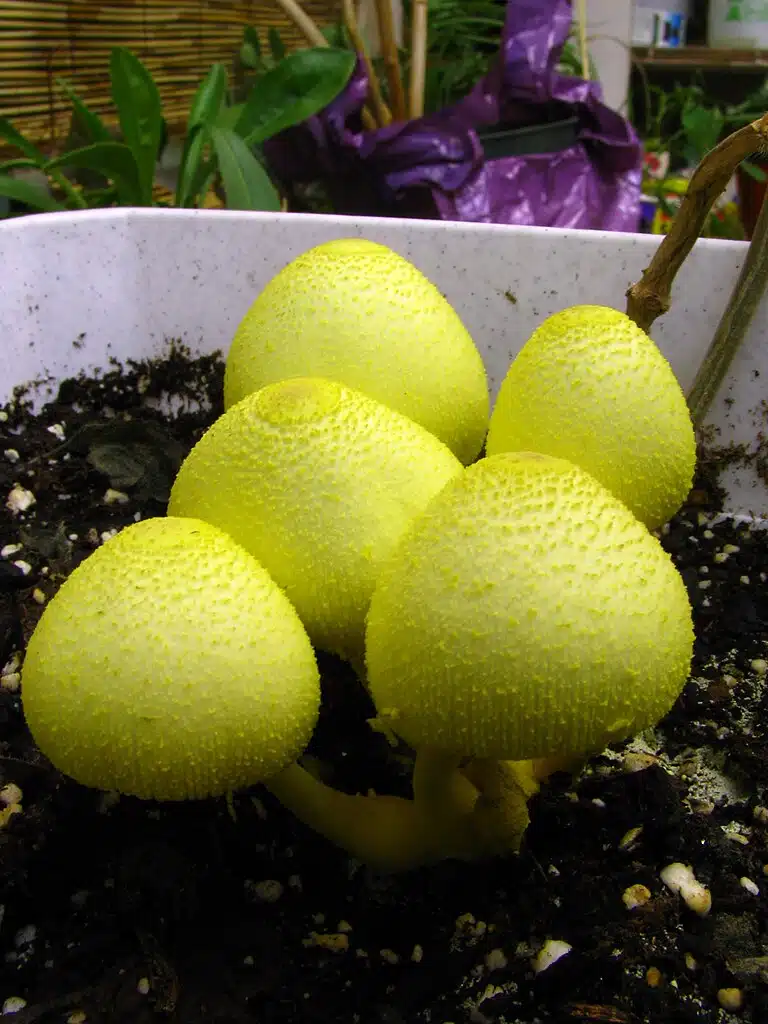
Scientific name: Leucocoprinus birnbaumii
Common name: Flowerpot Paraso, Yellow Parasol
Yellow nuances are specific to Flowerpot Parasol. This is a species with a common distribution as it often arises next to flowers in pots.
It can also grow next to other types of plants in pots such as succulents and cacti.
Their presence in pots may be beneficial but too many Flowerpot Parasols are a sign of concern and a sign that the soil in the pot is too damp.
As a result of overwatering, these mushrooms show a thin yellow stipe and a matching yellow cap.
While they may darken over time, they show pale yellow gills throughout the growth stages.
6. Yellow American Blusher
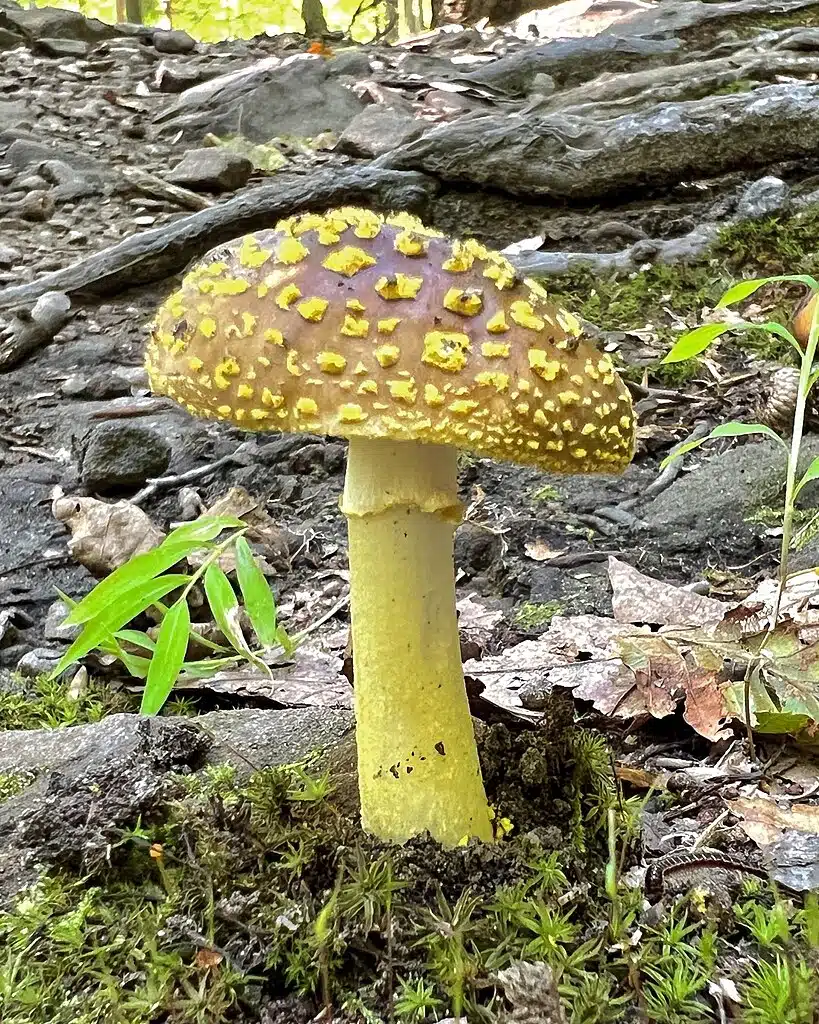
Scientific name: Amanita flavorubens
Common name: Yellow American Blusher, Yellow American Blushing Amanita
Pale yellow caps are descriptive of the appearance of Yellow American Blushers.
The same yellow nuance is also seen on the upper stipe as the lower part is typically white.
The older a Yellow American Blusher mushroom is the paler its appearance. This is why the more vivid yellow caps are specific to younger mushrooms.
Yellow cap margins tend to brighten first, followed by the central section of the cap.
Believed not to be edible, the mushroom is primarily found in the Northern parts of the US.
Its expansion has confirmed the species on Mexican woodlands as well but to a lesser extent.
Yellow American Blushers primarily grow in beech woodlands but they are also present at higher elevations among pine.
7. Golden Oyster Mushroom
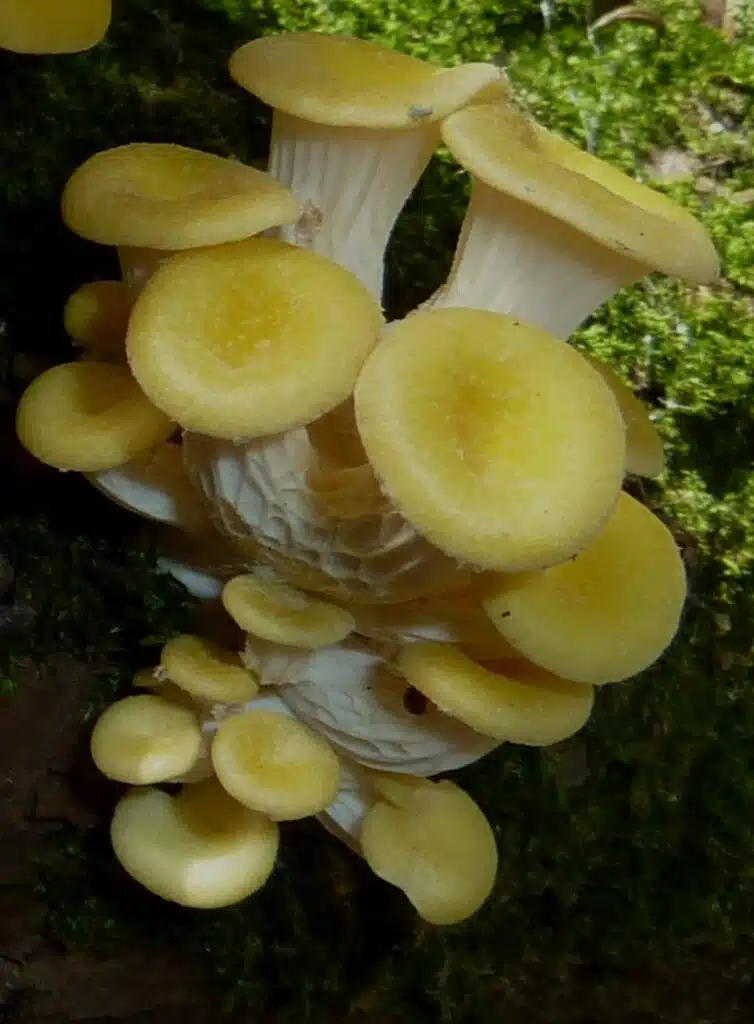
Scientific name: Pleurotus citrinopileatus
Common name: Golden Oyster Mushroom
Mostly growing in East Asia, Golden Oyster Mushrooms have a yellow cap at first and a golden yellow cap as they row.
Some caps may additionally turn brown in the center when widest as well.
When it comes to size, the yellow caps of Golden Oyster Mushrooms grow to about 2 inches at best.
A wide white stem with gills is also specific to these mushrooms that grow in clusters on decaying wood.
They can even be cultivated on wood and sawdust.
While not eaten all around the world, these mushrooms are widely common in parts of East Asia but don’t have a particularly flavorful aroma.
While the taste isn’t highly memorable, Golden Oyster Mushrooms are believed to contain plenty of antioxidants.
8. Smooth Chanterelle
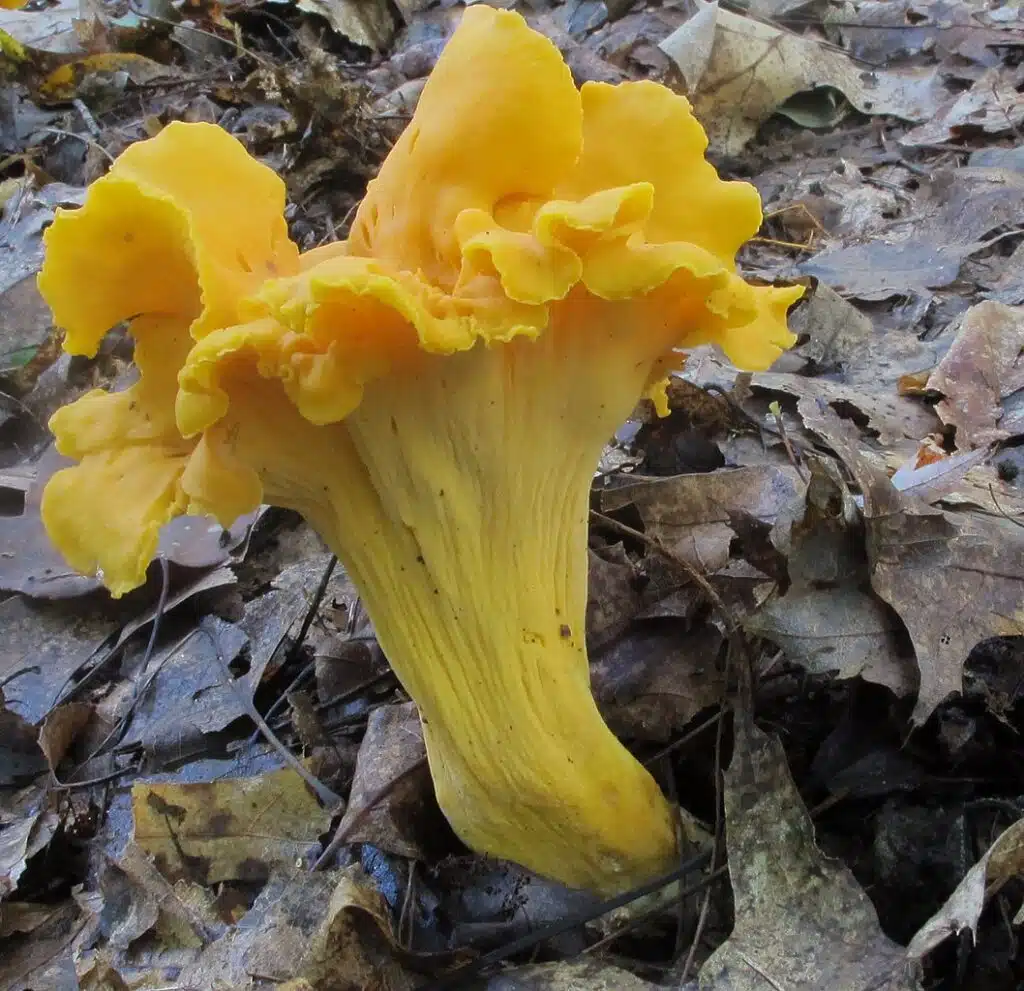
Scientific name: Cantharellus lateritius
Common name: Smooth Chanterelle
A dark yellow nuance or a yellow-orange nuance dominates the appearance of Smooth Chanterelle.
These mushrooms can remain yellow or pale yellow as they grow but they can also get an orange cap nuance in their later stages.
These types of mushrooms grow across multiple continents, including Africa and North America.
In The United States, Smooth Chanterelles are mostly found across Eastern forests where they grow in late summer.
Smooth Chanterelles are associated with oak woodlands and are known to become orange, at times.
Often picked, these mushrooms are edible and sweet tasting.
Their taste is compared to fruit-like taste and can be flavorsome on its own or in dishes.
By some sources, Smooth Chanterelles also smell sweet.
9. Golden Pholiota
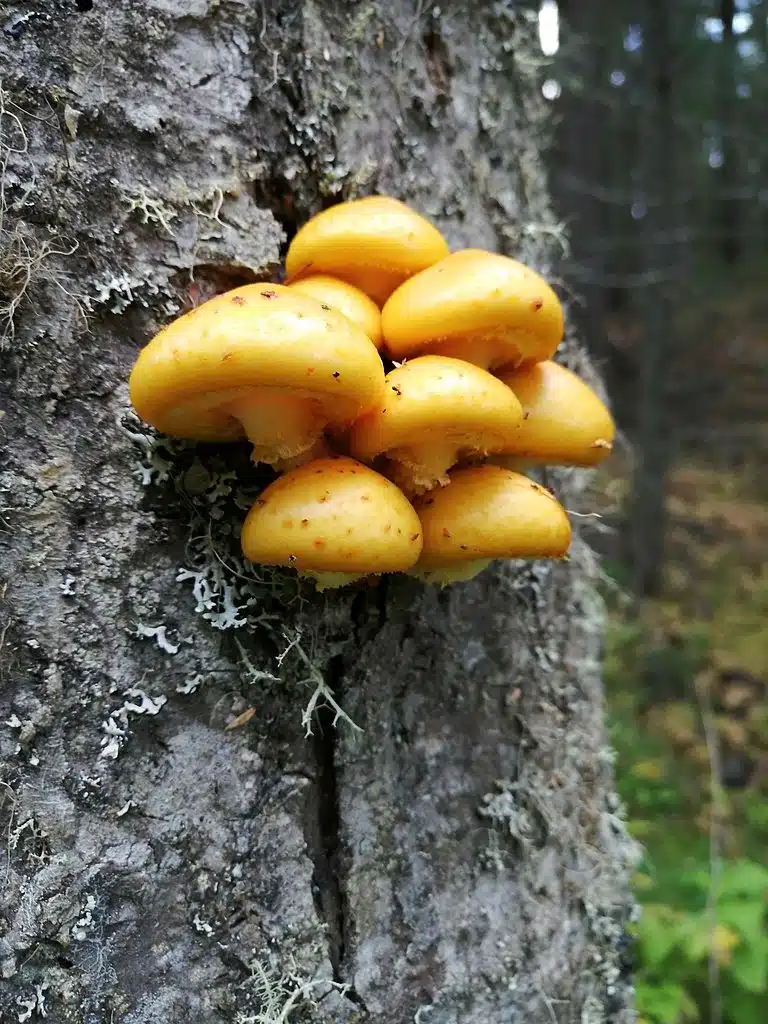
Scientific name: Pholiota aurivella
Common name: Golden Pholiota
As Smooth Chanterelles, Golden Pholiotas also grow in late summer and early fall.
Depending on their region around The Northern Hemisphere, Golden Pholiotas can also grow into the winter.
They are the mark of a dead tree as they only grow on dead tree parts, often on the trunk or the thicker branches.
In terms of color, Golden Pholiotas range from pale yellow to darker golden nuance or even to orange cap nuances.
Small scales sometimes cover the caps of these mushrooms. These scales might be too small to be visible with time, as rain washes them away.
Their short stipe can be white, pale yellow, or yellow as well.
Listed as non-edible, the mushrooms shouldn’t be picked as they may even be toxic.
10. Ornate-stalked Bolete

Scientific name: Retiboletus ornatipes
Common name: Ornate-stalked Bolete
Mushrooms of this species also grow in the eastern woodlands of North America.
They have an all-yellow appearance or a yellow-and-brown appearance as some darken with age.
Identified by their wide yellow stipes with orange spores, these mushrooms tend to darken over time.
The cap can become brown, gray, or olive.
Yellow nuances dominate the stipe across the growth stages of the mushroom. A tendency to grow in a curved manner is specific to these wide stipes.
The edibility status of these mushrooms is debated. Most sources don’t recommend eating Ornate-Stalked Boletes.
11. Chicken Fat Mushroom
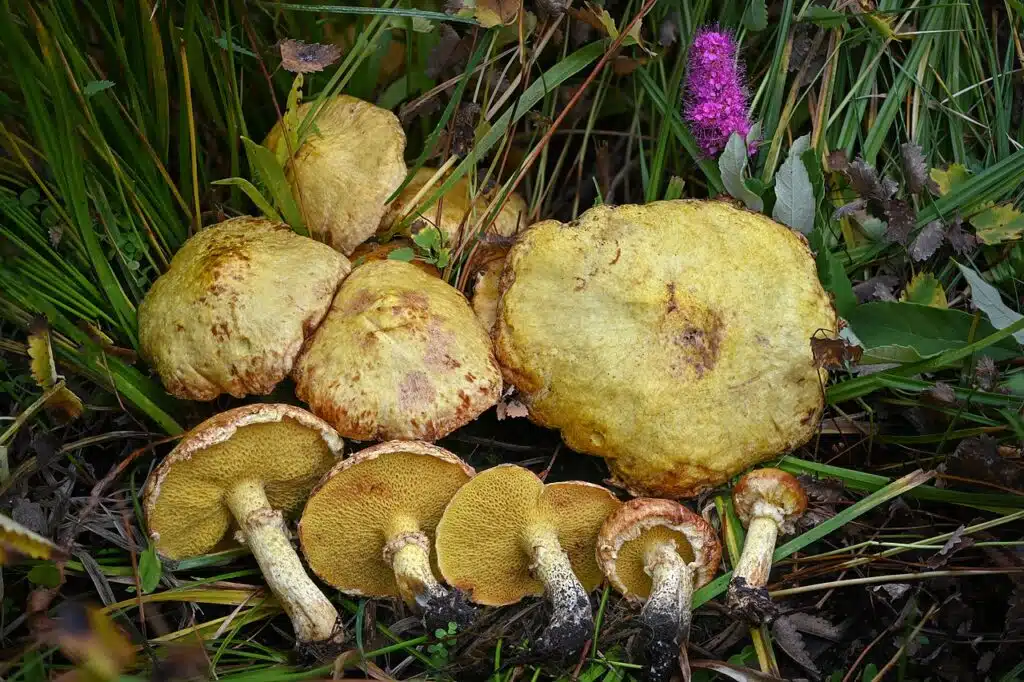
Scientific name: Suillus americanus
Common name: Chicken Fat Mushroom, American Suillus
Chicken Fat Mushrooms are mostly yellow on the cap and on the stipe. Even the pores of the species are small and yellow.
Orange marks are sometimes spotted on the cap, as it grows.
These types of mushrooms grow in North America and in Asia.
While there are some sources claiming they aren’t edible, the mushrooms are named after their presumably chicken-like taste.
Flavorsome and sometimes picked in some regions of the world, Chicken Fat Mushrooms have thin flesh to be worth collecting despite sometimes reaching a height of over 3 inches.
Growing in small numbers and solitarily, these mushrooms are associated with pine species such as The Eastern white pine.
12. Golden Waxy Cap
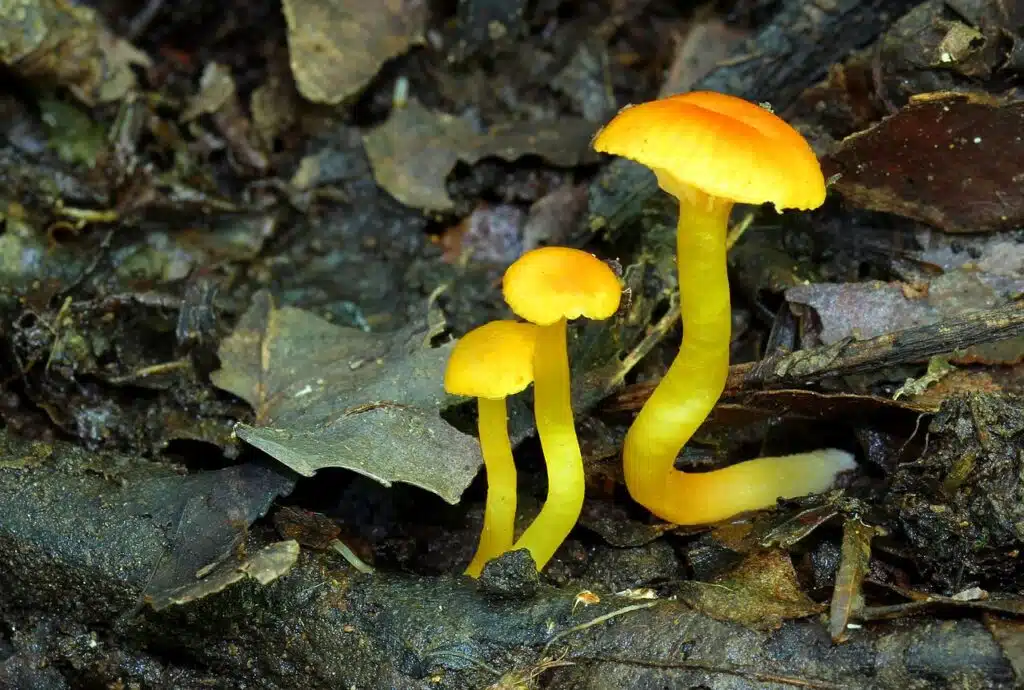
Scientific name: Hygrocybe flavescens
Common name: Golden Waxy Cap
Yellow and yellow-orange nuances dominate the appearance of Golden Waxy Caps.
Unlike other yellow-orange mushrooms, Golden Waxy Caps brighten as they grow until they become completely yellow.
The gills also show a pale yellow color throughout the growth stages.
Golden Waxy Caps are present both in European and American woodlands.
They grow both in coniferous and broadleaf woodlands. These mushrooms grow from the West Coast to The East Coast across The United States.
Some of the higher numbers of mushrooms are specific to areas with coastal redwood.
13. Golden Milkcap
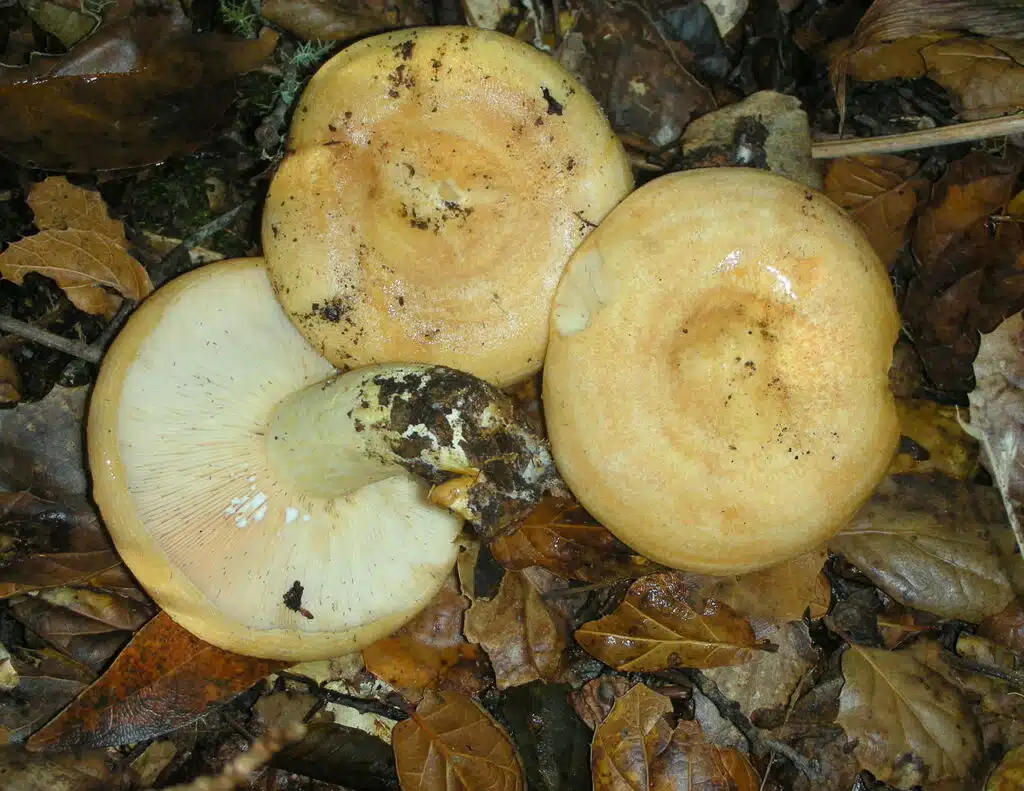
Scientific name: Lactarius alnicola
Common name: Golden Milkcap
Golden Milkcaps are among the larger types of yellow mushrooms in North America and even the world. Some of the larger fungi of the species reach a cap diameter of up to 7.9 inches.
The cap itself has a bright yellow color while the stipe that grows to 2 inches is mostly yellow but may additionally show dark brown patterns.
As their name implies, the mushrooms ooze a white sap-like milky liquid when bruised.
This liquid is believed to be too peppery for human consumption which makes Golden Milkcaps not edible.
Some of the common areas they grow in are woodlands as they only grow under trees.
Pine woodlands of The US such as those of fir are ideal for Golden Milkcaps.
14. Golden-gilled Gerronema
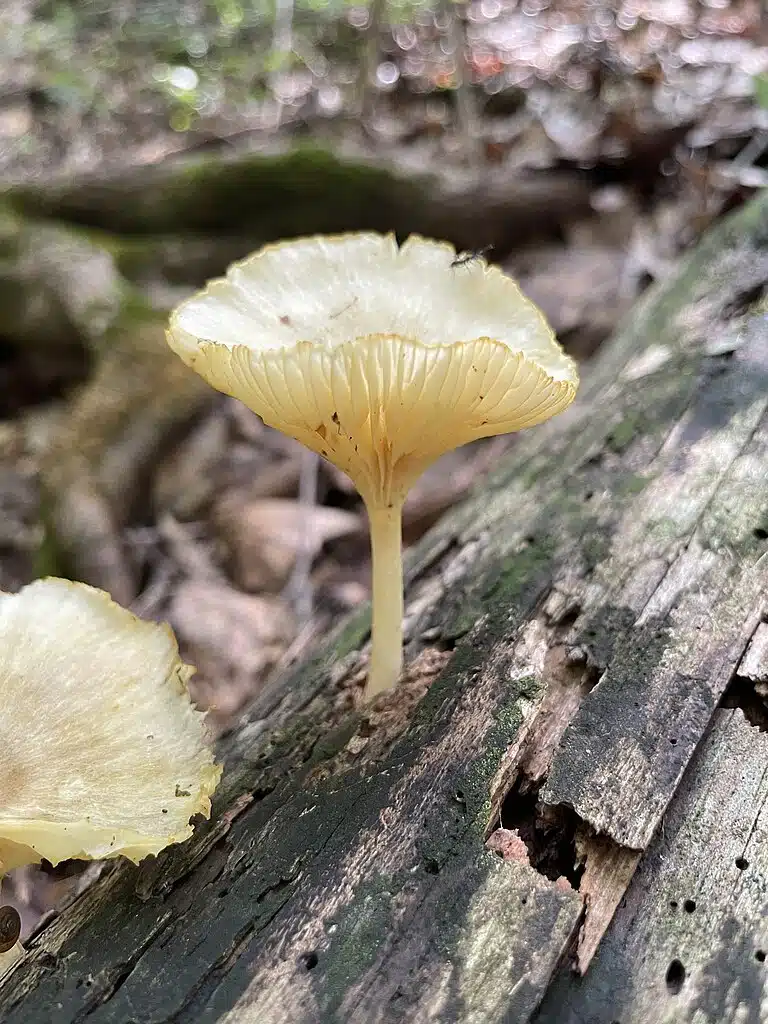
Scientific name: Gerronema strombodes
Common name: Golden-gilled Gerronema
Some mushrooms become yellow in later growth stages, as are Golden-gilled Gernonemas. The caps of these mushrooms are initially dark, having a brown nuance.
They eventually become yellow and white as they grow out. A typical grown yellow cap can have a diameter of up to 4 inches.
Golden-gilled Geronemas additionally show short white and gilled stipe appearance.
They grow on decaying vegetation, mostly on decaying oak.
In North America, these types of mushrooms grow on the East Coast as well as further North into Southern Canada.
The edibility status is unknown but some sources claim they can even be potentially toxic.
15. Small Chanterelle
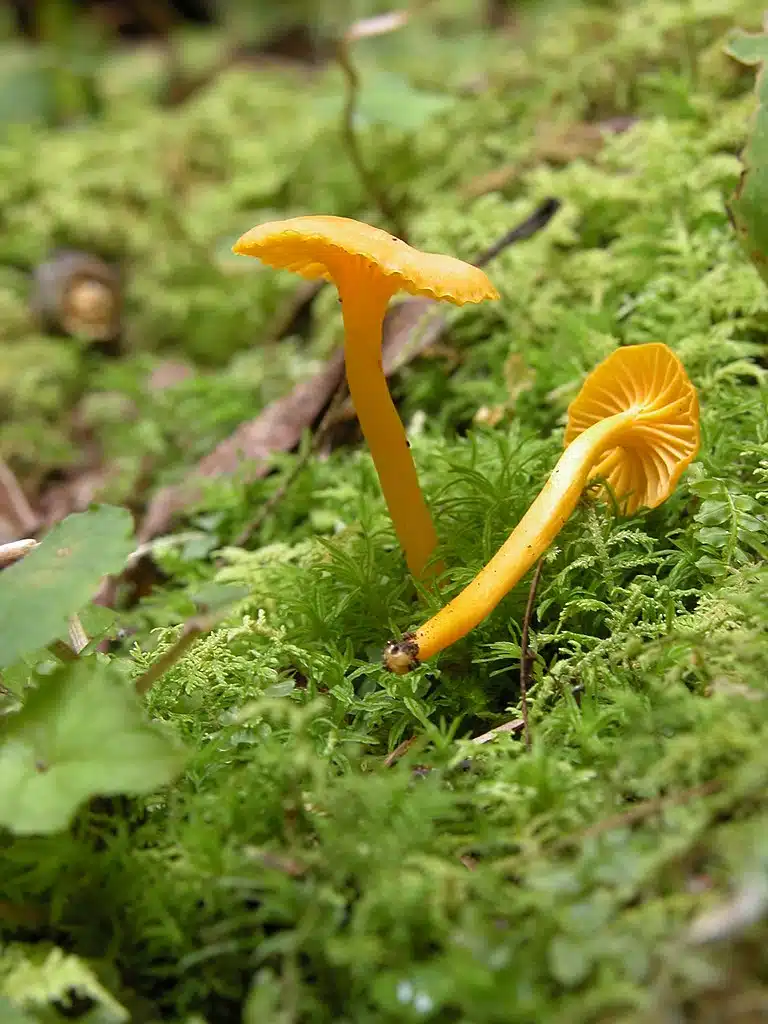
Scientific name: Cantharellus minor
Common name: Small Chanterelle
Believed to be one of the representative species of yellow mushrooms of North America, Small Chanterelles also grow in other regions of the world.
The type of habitat they prefer varies according to their region. Fungi of the species like to grow in association with oak trees in North American woodlands.
In other areas, they can grow next to other types of trees and even in a mutually beneficial relationship with moss.
For example, while they don’t grow under oak trees in regions of India, they still grow under broadleaf trees such as white dammars.
The mushrooms are fairly easy to identify given they have a yellow cap, similar gills, and stipe coloring.
They remain small, growing to a height between 0.7 and 2 inches at best.
16. Western Jumbo Gym
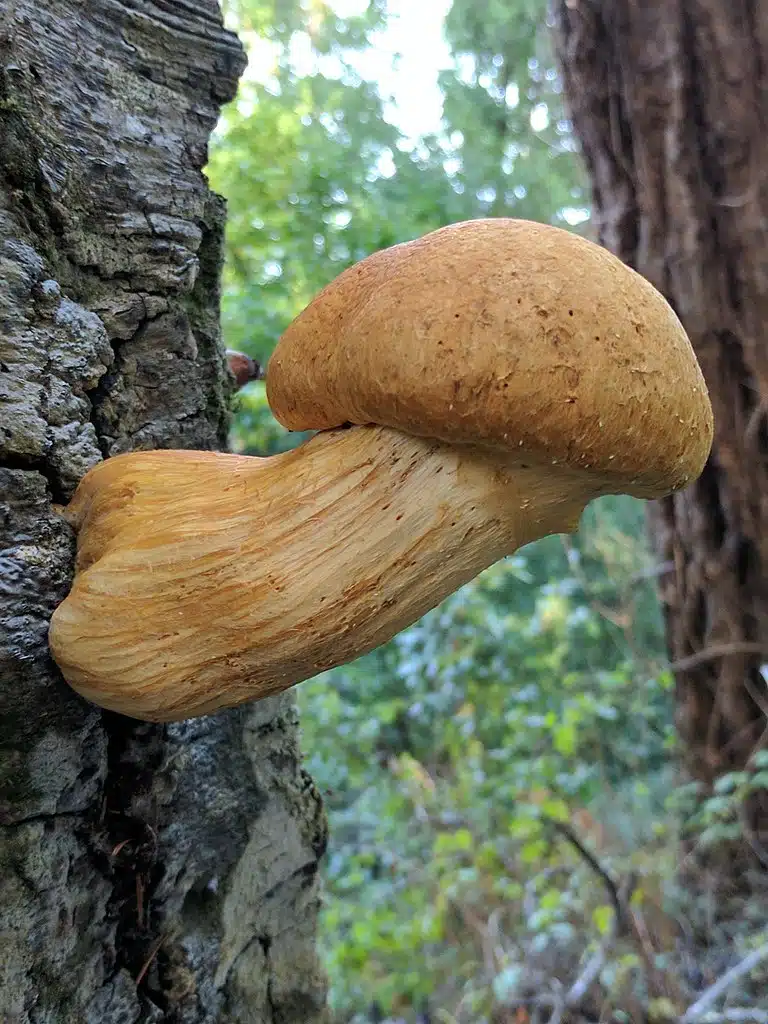
Scientific name: Gymnopilus ventricosus
Common name: Western Jumbo Gym
Western Jumbo Gym mushrooms are part of a wider group of fungi that darken from an initial yellow nuance over time.
They don’t become brown but they do get an orange nuance on the cap while the stipe and the gills remain yellow-orange, with lesser darkening characteristics.
Western Jumbo Gyms grow on dead or dying trees, often in layers. They feature a centered stipe but a bent stipe if they grow vertically along the tree trunk.
In some cases, they may also appear to grow on the ground, next to a dead tree. Even these fungi grow on buried wood.
The size of the cap places them almost on top of the list of the largest yellow mushrooms. Cap diameter may measure up to 7.8 inches in some cases.
While not toxic, these mushrooms have a highly unpleasant flavor and grow well into the winter.
17. Flame Chanterelle

Scientific name: Craterellus ignicolor
Common name: Flame Chanterelle, Yellow Foot
Eastern forests of North America are home to Flame Chanterelle. An edible species, these mushrooms are probably not worth collecting due to their reduced size.
They show yellow and yellow-orange nuances across the cap, stipe, and their fake gills.
Only found in the higher humidity areas of forests, Flame Chanterelles grow under trees they are in a beneficial relationship when it comes to nutrients.
This species can grow scarcely but they are seen in small groups more often. Pickers are usually able to locate additional mushrooms of the species nearby.
When it comes to size, a thin mushroom of just 0.5 inches might not represent an ideal choice for picking.
18. Pacific Golden Chanterelle
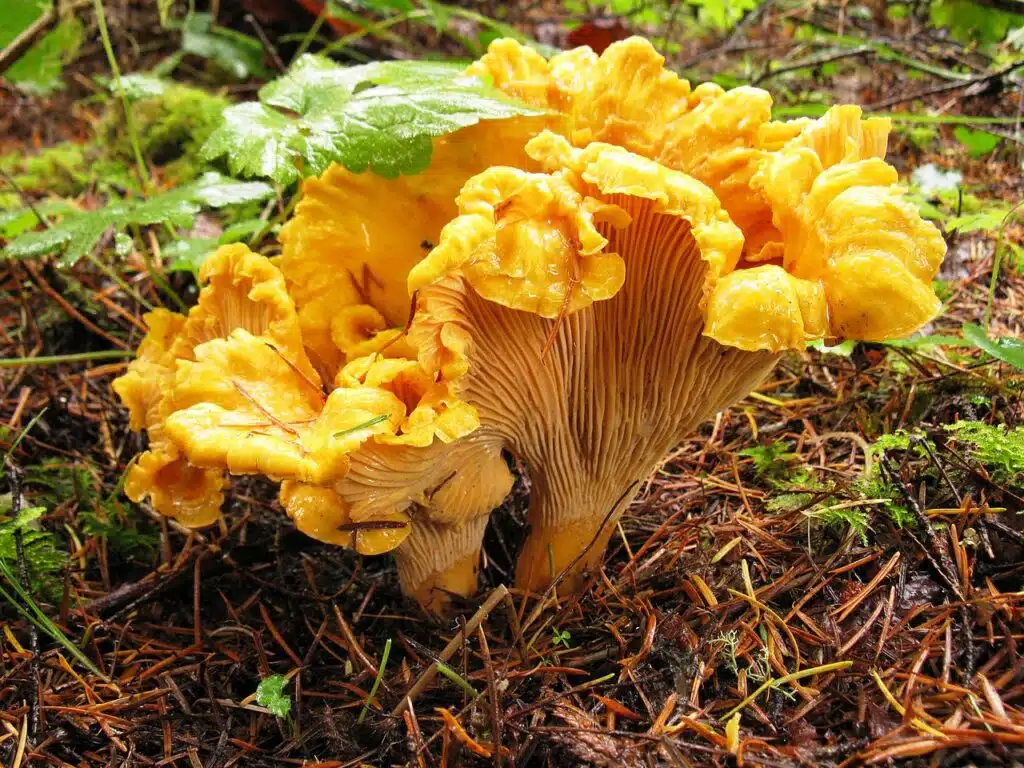
Scientific name: Cantharellus formosus
Common name: Pacific Golden Chanterelle
Some yellow types of mushrooms are edible and highly available in stores and restaurants.
Pacific Golden Chanterelles are among these mushrooms which are recognized for their floral and fruity flavors.
The mushrooms show a yellow or yellow-orange appearance with fake gills and a wavy cap.
Yellow nuance is always brighter on the stipe than on the cap.
While they are grown for retail, they are still naturally available in coniferous woodlands across The United States.
Some of the areas they are found in higher numbers include The West Coast.
Their popularity is recognized around the world where they are cooked in different ways, including frying with carrier oil or butter.
19. Southern Jack-O’-Lantern
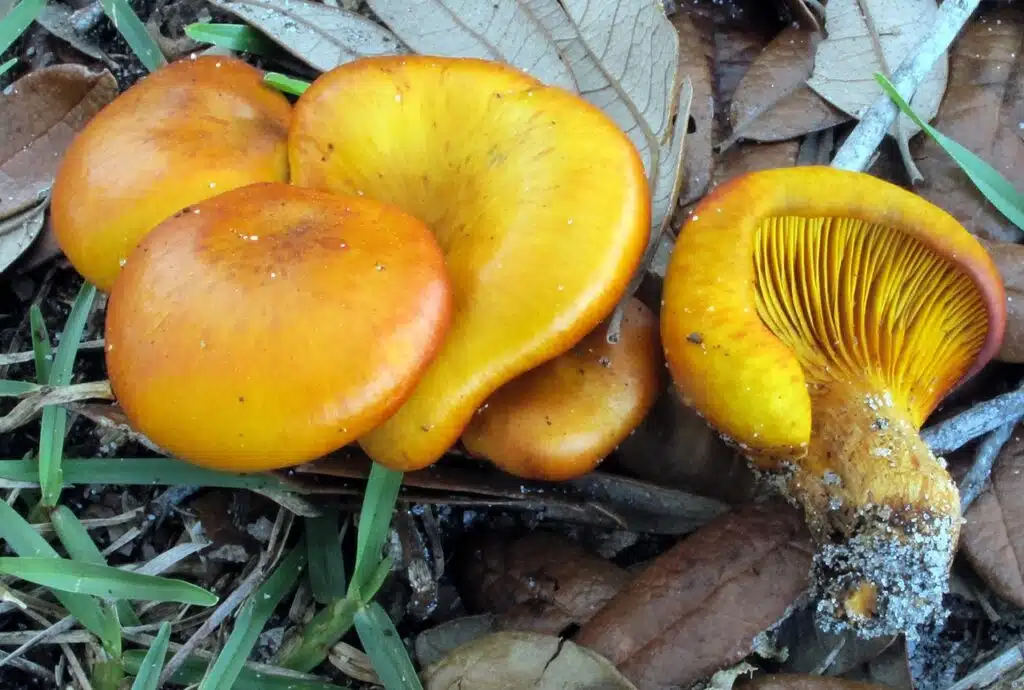
Scientific name: Omphalotus subilludens
Common name: Southern Jack-O’-Lantern
Some of the weirdest mushrooms in the world are also yellow. Southern Jack-O’-Lanterns glow in the dark.
This is a process known as bioluminescence and it’s quite a sight, albeit rare in North America.
Some of the states where these glow-in-the-dark mushrooms can be spotted include Texas and Florida as they are absent from other Northern regions.
The mushrooms can be large, with a cap expanding to 4-5 inches.
Mostly orange, the cap does get a few yellow strikes as well as yellow-orange nuances on its inner side.
The role of these fungi in medicine is believed to be significant as they may act as a natural anticoagulant.
20. Yellow Deer Mushroom
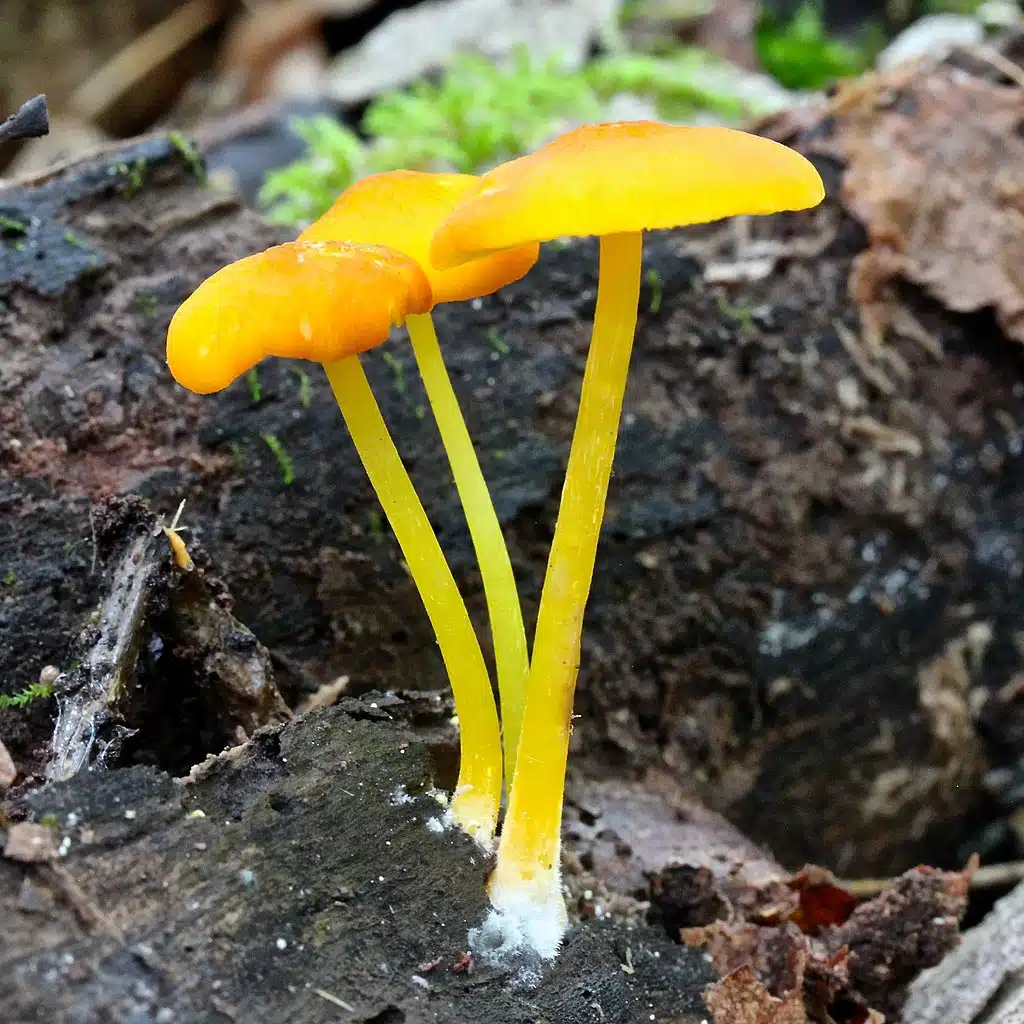
Scientific name: Pluteus chrysophlebius
Common name: Yellow Deer Mushroom
A common mustard-yellow species in Western North America, Yellow Deer Mushrooms are some of the smallest of this type.
Even when reaching their full size, they can be as small as 0.5 inches.
Yellow Deer mushrooms grow on trees where they initially have a bell-shaped cap. This cap flattens out and also maintains its mustard-yellow nuance.
Brighter yellow nuances are specific to its stipe. Lower parts of the stipe are even brighter and may also be white.
Its gills have a yellow or salmon color, depending on their location.
Growing in small clusters, these types of mushrooms are a sign of dead wood nearby.
They are believed not to be edible by most sources.
Some of their preferred growing periods include the end of the summer with a season ending in September.
21. Persistent Waxcap
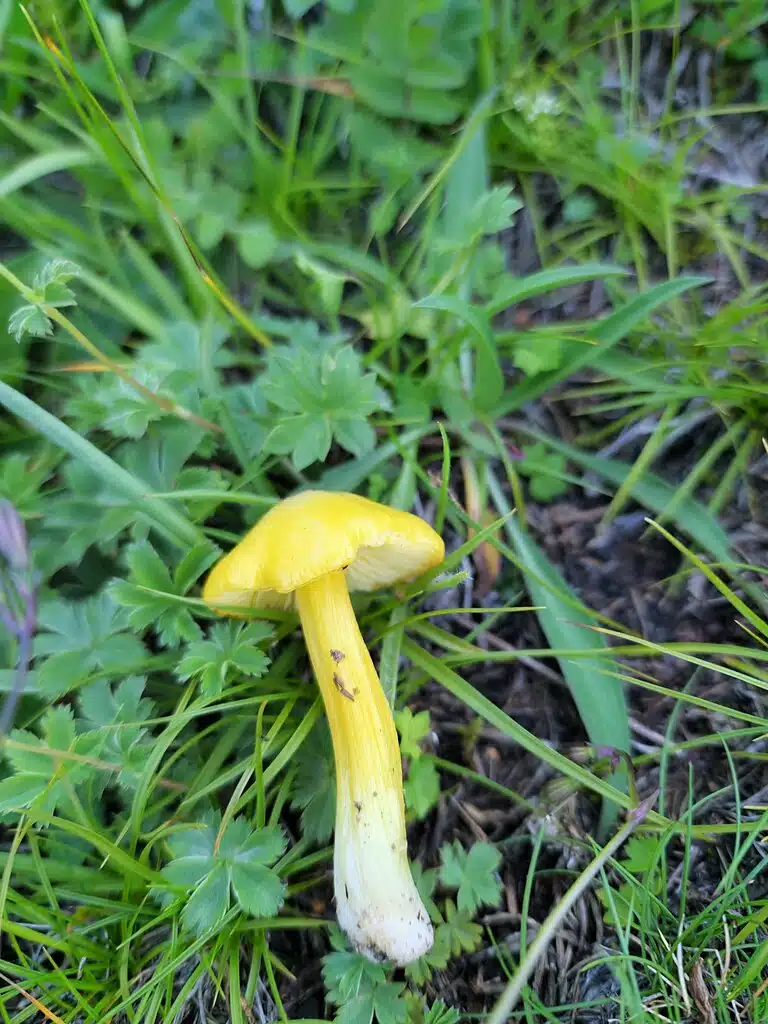
Scientific name: Hygrocybe acutoconica
Common name: Persistent Waxcap
Mostly a European species, Persistent Waxcaps are some of the rarest types of yellow mushrooms in the world.
They prefer shaded and high moisture areas next to rivers when they grow in grasses.
While a rare sight, the mushrooms only grow on moss as they add benefits in terms of nutrition.
Some of these mushrooms also grow in sandy areas.
The edibility status of the species is debated. While rare, Persistent Waxcaps grow well into the winter in temperate climates.
22. Peck’s Yellow Dust Amanita

Scientific name: Amanita elongata
Common name: Peck’s Yellow Dust Amanita
A tall species, Peck’s Yellow Dust Amanitas has a yellow cap that slowly turns dark yellow.
In rare cases, the cap remains bright yellow throughout the various growth stages.
Its elongated thin stipe is mostly white, with a yellow collar on the upper part.
Mossy areas tend to be the ideal habitat for this species. Commonly found in woodlands, the mushroom may also grow in parks or on lawns where high humidity favors moss growth.
Most of the range of these fungi are specific to Canadian territories, with occasional sightings in the Northeastern US woodlands.
The species is believed not to be edible as it lacks any type of aroma or smell.
23. Frost’s Amanita
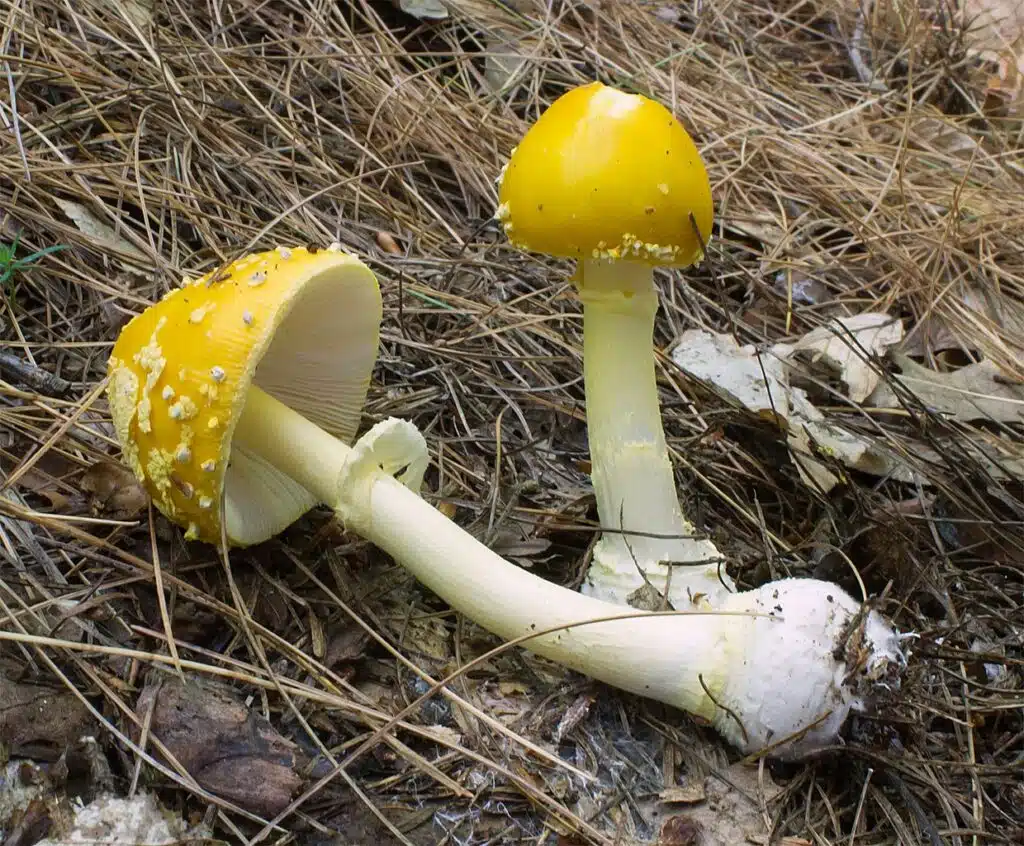
Scientific name: Amanita frostiana
Common name: Frost’s Amanita
Another species with a dual presence in Canada and The United States which is sometimes yellow is Frost’s Amanita.
A species that is mostly yellow, the mushroom may also be orange, red, or bright brown.
The cap tends to show variable nuances alike. Yellow caps are both bright yellow and dark yellow in the central area.
The same darker central area is also seen in its orange or orange-red variants.
A long white stipe is seen on all of these variants but there’s a collar that is also yellow at times.
The species additionally shows white flecks on the cap which can get washed away by rain.
Initially egg-shaped, the cap of the species flattens out, while the flecks slowly wash away.
According to multiple sources, staying away from the species is recommended due to their potentially toxic compounds.
24. Yellow Knight
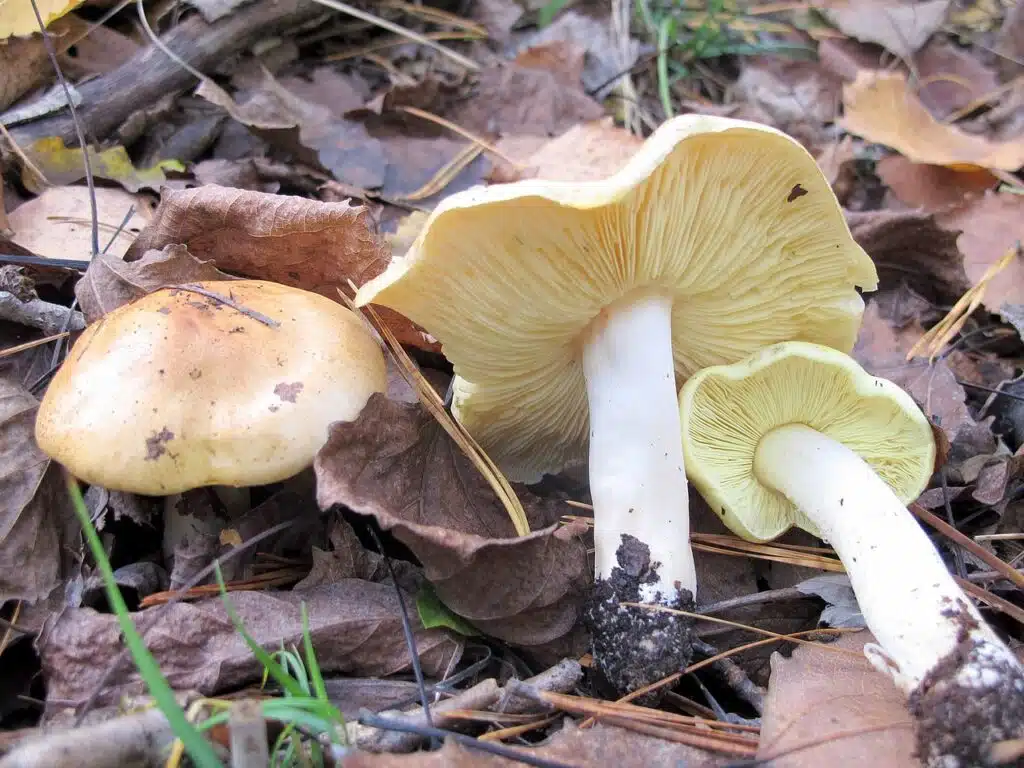
Scientific name: Tricholoma equestre
Common name: Man on Horseback, Yellow Knight
Yellow Knight Mushrooms have a bright yellow cap which may additionally darken in the central area over time.
Pine and oak trees mark the ideal growing locations for Yellow Knight, both in Europe and North America.
Even more, these mushrooms are best kept away from as they can be deadly.
There are no reports of toxic reactions to the species in North America, unlike in Europe.
Sometimes eaten locally, this species is believed to cause toxicity and adverse health reactions even days after they’ve been eaten.
The season of Yellow Knights differs by region. Cooler Northern regions see it grow at the end of the spring but these fungi mostly arise in mid-summer, growing up until early October.
25. Golden Coincap

Scientific name: Cyptotrama chrysopepla
Common name: Golden Coincap
A bright yellow color is specific to the cap and stipe of Golden Coincap. These fungi slowly turn golden as they grow, mostly on the cap.
Both the cap and the stipe of Golden Coincaps show an uneven surface with yellow flecks.
Growing on dead wood, Golden Coincapremain some of the rarest types of yellow-golden mushrooms in the world.
No information is found in their edibility but it’s believed they aren’t worth collecting.
While rare, Golden Coincaps still grow in groups. Small clusters of up to 15 mushrooms are defined for the species.
In most cases, just a few mushrooms are seen together.
26. Western Yellow Mycena
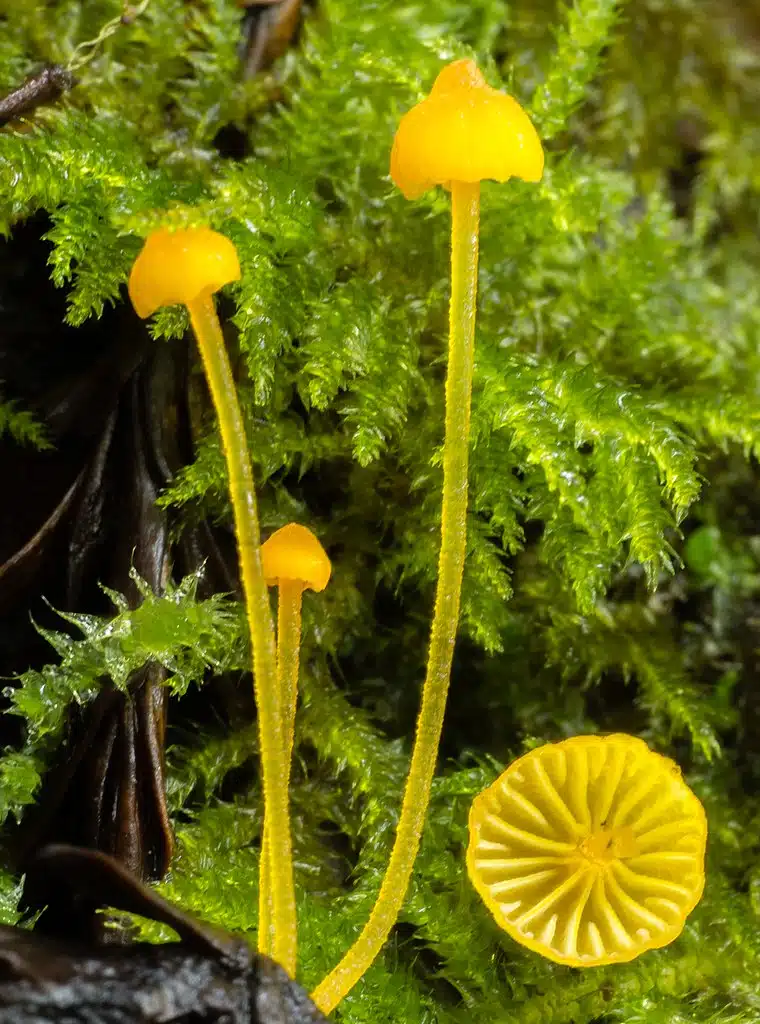
Scientific name: Mycena oregonensis
Common name: Western Yellow Mycena
Yellow and orange colors are specific to Western Yellow Mycenas. These types of small mushrooms are a rare find but tend to stand out immediately based on their vivid colors.
The globular cap is initially yellow, becoming orange on top and only remaining yellow on the margins.
A yellow nuance is also specific to the elongated stipe of these fungi.
Wide lemon-yellow gills complete the bright appearance of Western Yellow Mycenas.
Growing both in Europe and North America, these mushrooms grow on dead pine trees.
Directly growing on wood itself is rare as they prefer to grow on decaying pine needles.
They are believed to have no taste and their reduced size makes them not worthwhile.
Even some of the tallest Western Yellow Mycenas can only reach a height of up to 0.5 inches.
27. Ghost Chanterelle
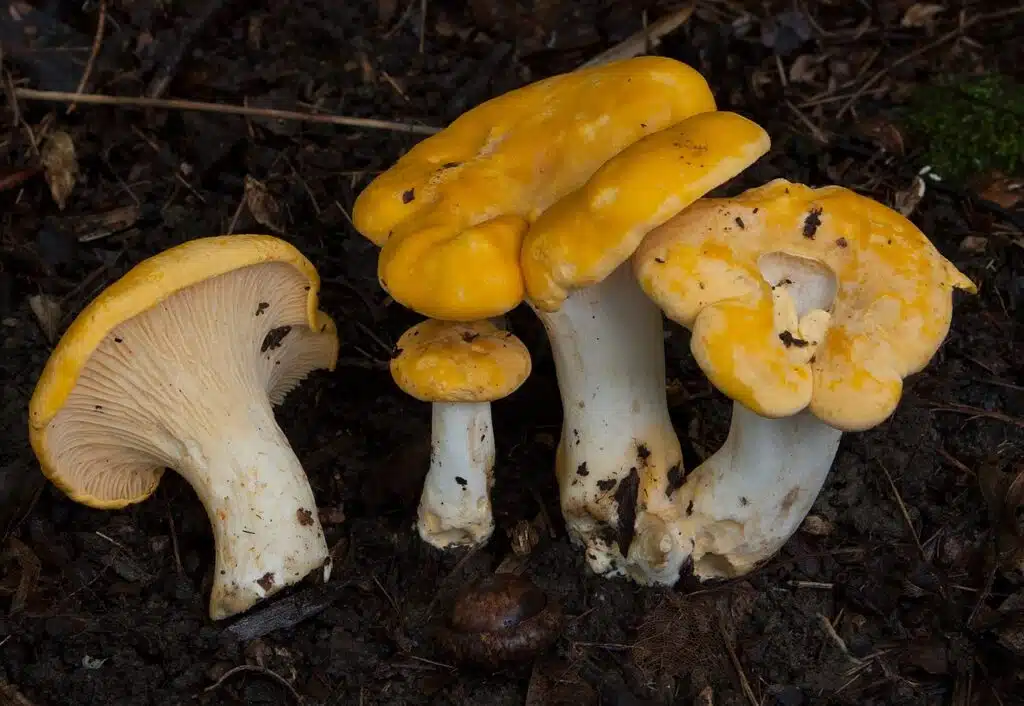
Scientific name: Cantharellus phasmatis
Common name: Ghost Chanterelle
One of the newest species of yellow mushrooms is Ghost Chanterelle.
Discovered just recently, this is a rare species believed to be occasionally spotted in Eastern US states.
The species features a distinct yellow cap that remains yellow throughout its life stages.
Its stipe and gills are white. The stipe of the species is wide, making the species easy to identify.
Not much information is available on the edibility of Ghost Chanterelle. On occasion, they are sold in local markets but are believed to be less flavorsome than other US chanterelles.
While rare, these mushrooms can sometimes be found from July to August in coniferous woodlands.
28. Yellow Fieldcap
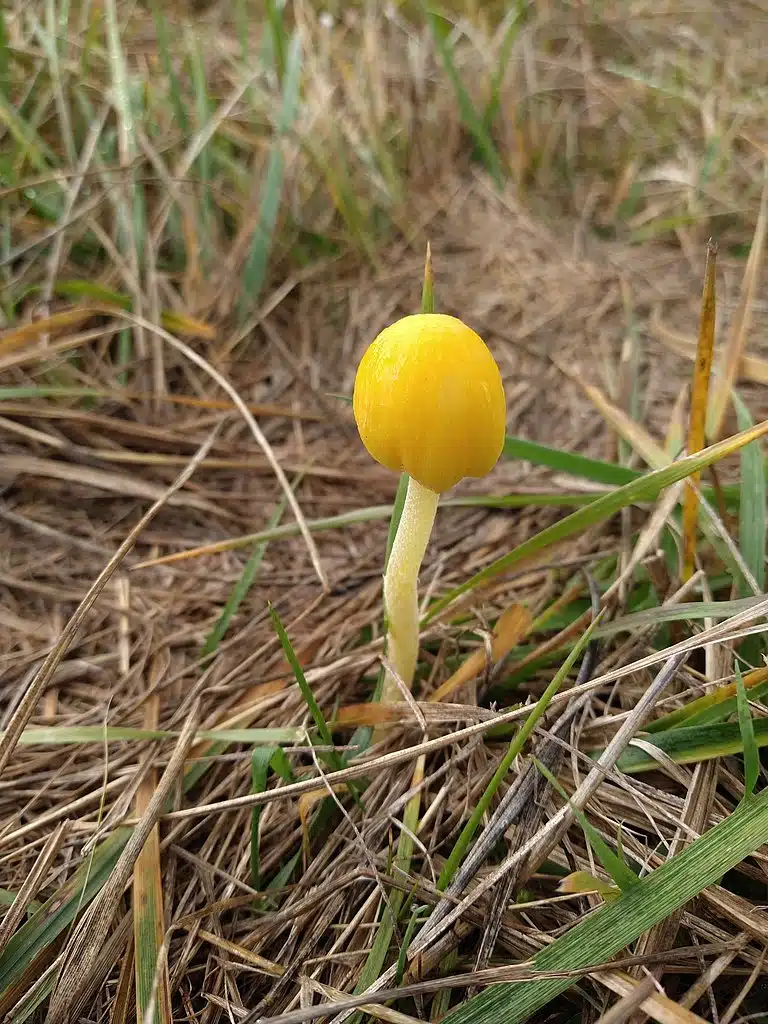
Scientific name: Bolbitius titubans
Common name: Yellow Fieldcap
A species mostly specific to crops, Yellow Fieldcaps grow on overfertilized soil. They can also grow on dung as well as on decaying vegetation.
A yellow cap with a white stipe is the color combination of the species. The egg-shaped cap slowly opens and flattens out, sometimes reaching a diameter of up to 4 inches.
Some of these mushrooms may get a green tint to their yellow caps on occasion.
Mostly small, these mushrooms additionally show small white flecks along the stipe.
Not believed to be edible given they grow directly on fertilizer, these mushrooms tend to grow in small groups. They appear after heavy rain and early fertilization in groups of up to 10-15.
29. Yellowfoot
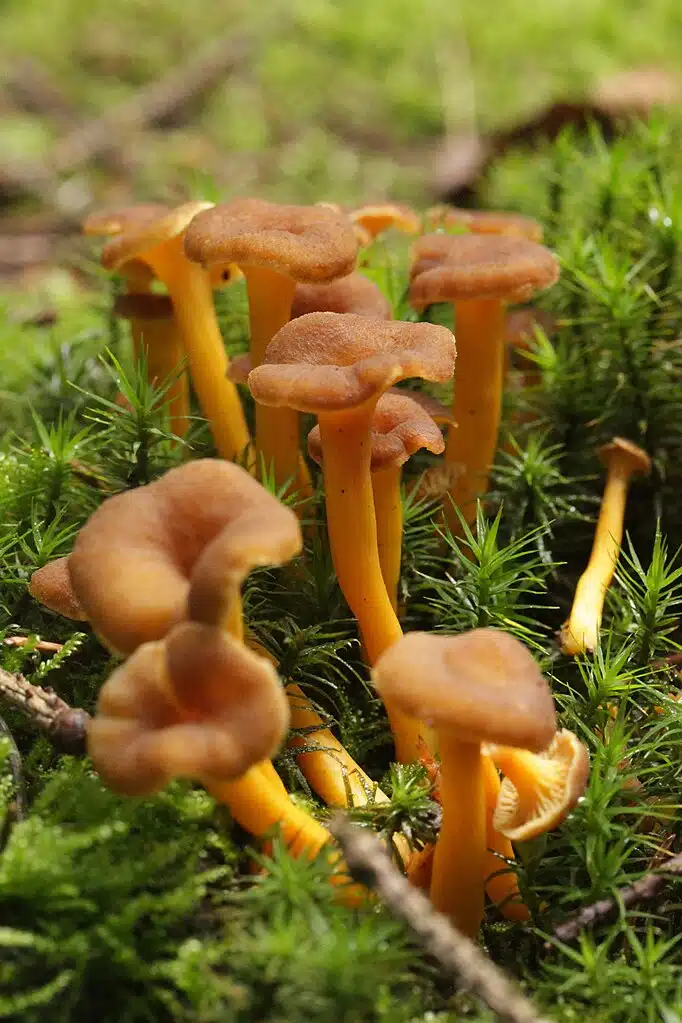
Scientific name: Craterellus tubaeformis
Common name: Funnel Chanterelle, Yellowfoot
One of the smaller tasty yellow mushrooms of the world are Yellowfoot mushroom. Identified by their trumpet-like shape, they are eaten when cooked in various ways.
Considered highly flavorsome, these mushrooms are indeed small and tend to be worthwhile only in large numbers.
While tall, sometimes reaching a height of 3 inches, the diameter of their trumpet-like caps is small, ranging from 0.3 to 2 inches.
Yellowfoot mushrooms tend to darken with time, at least on the cap as the gills remain bright yellow.
An olive or olive-gray nuance might be the final color the species settles on for the cap.
The upper part of the stipe also darkens with time while the lower part remains bright yellow.
Growing in areas with plenty of decaying vegetation, Yellowfoot mushrooms are found in the woodlands across the world. Growing in North America, they also have a widespread presence in East and South Asia.
30. Yellow Gymnopilus

Scientific name: Gymnopilus luteus
Common name: Yellow Gymnopilus
Yellow and yellow-brown nuances cover Yellow Gymnopiluses. These mushrooms grow up until late November on dead wood in hardwood woodlands.
Present both in Europe and North America, they can reach a cap diameter of up to 7 inches.
The cap itself is yellow with a central brown section later on. Its stipe is also yellow while the spores are brown.
Considered highly bitter, this mushroom isn’t edible and it may even bruise.
Mostly growing in small numbers on logs and dead branches, the species may appear edible due to a sweet fruit-like smell but it shouldn’t be picked.
31. Shining Waxcap

Scientific name: Gloioxanthomyces nitidus
Common name: Shining Waxcap
Small and trumpet-shaped, Shining Waxcaps are native to North America where they grow in woodlands.
Only the higher humidity areas of the woodlands are ideal for their spread. This is why they grow next to water or in swampy areas.
A golden yellow nuance covers the entire fungi. Both the cap and the stipe have this bright nuance, together with the small gills.
Generally small, Shining Waxcaps may be smaller or slightly larger than 1 inch in diameter and up to several inches in height.
Small differences between Shining Waxcaps exist in terms of looks with age. They tend to become slightly darker as they grow.
32. Yellow Swamp Brittlegill
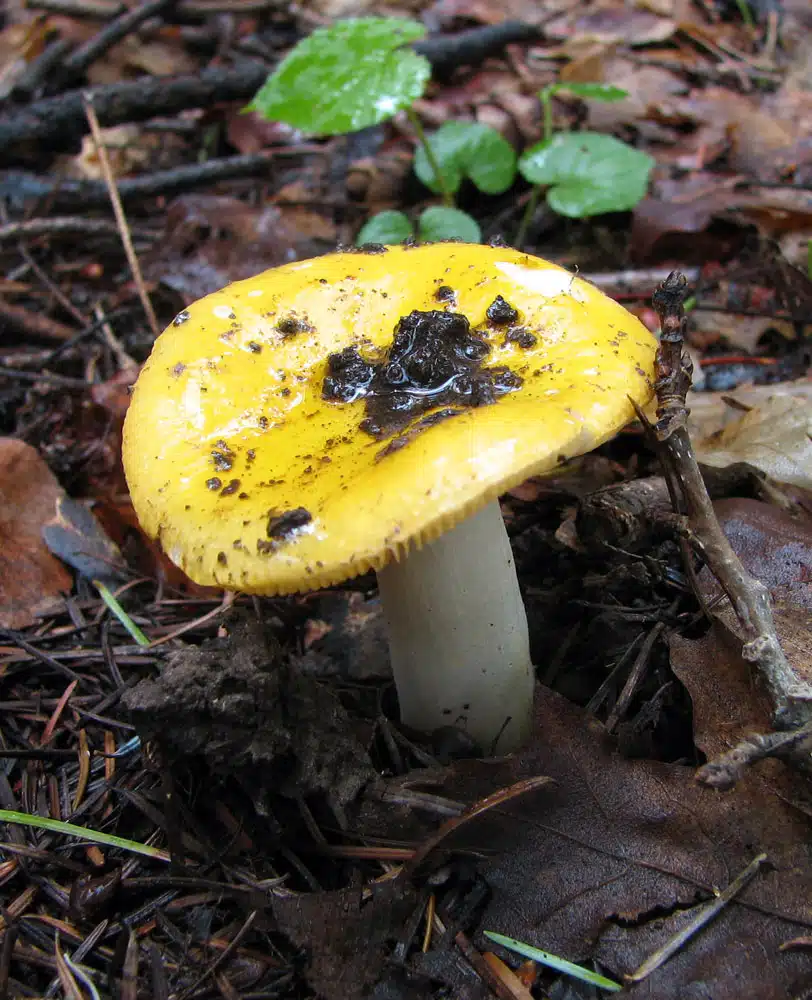
Scientific name: Russula claroflava
Common name: Yellow Russula, Yellow Swamp Russula
A vivid yellow color uniformly covers the cap of Yellow Swamp Brittlegills, a species that also likes high humidity.
The wide stipe has pure white coloring while the gills show an ochre nuance.
Despite bruising gray, Yellow Swamp Brittlegills are considered edible. They might not be worth picking in many cases as they barely grow wider than 1-2 inches. Only the largest ones get to a diameter of up to 4 inches.
When they grow to a larger size, Yellow Swamp Brittlegills also show a small lower central cap section as it flattens.
33. Shaggy-stalked Bolete
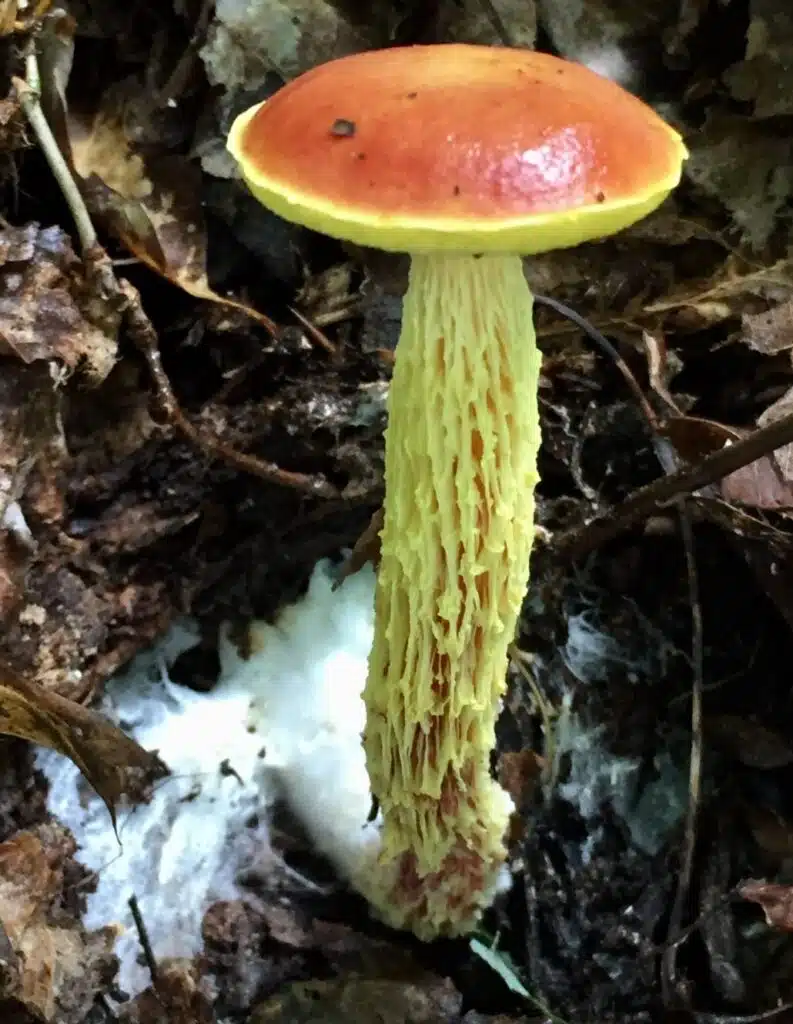
Scientific name: Aureoboletus betula
Common name: Shaggy-stalked Bolete
While weird-looking, Shagy-stalked Boletes are among the edible mushrooms of the Boletaceae.
Yellow pores and a yellow cap are seen on the fungi. Darkening tendencies are accentuated on the species which may turn red-brown or brown on the cap.
This type of mushroom is also easier to identify given its stipe appearance. The white-yellow and pink stipe has a texture that reminds of bark.
The stipe also tends to stand out more as the flattened cap tends to remain small. It measures just 0.4 to 2 inches, at best.
34. Blue-staining Slippery Jack
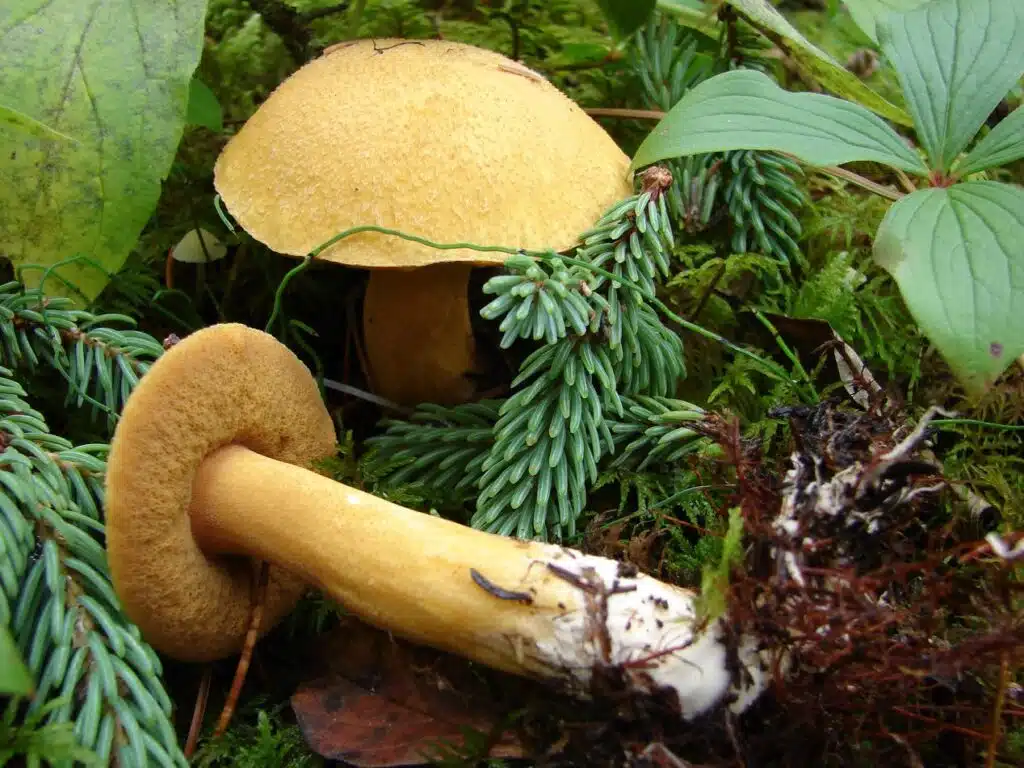
Scientific name: Suillus tomentosus
Common name: Blue-staining Slippery Jack
Yellow nuances are common on the Blue-staining Slippery Jack. Its cap turns slightly brown as it grows but its stipe remains yellow.
Even the flesh of these mushrooms is mostly yellow. Its spores also show a dark yellow nuance.
Most commonly, Blue-staining Slippery Jacks are found in Western parts of North America.
They are further known to grow in Mexico.
Pine woodlands represent their preferred natural habitat where they tend to grow seldomly or scarcely.
The season of the species varies by location. Mushrooms in warmer Southeastern parts of The US have a long growth season, including the winter months.
Blue-staining Slipper Jacks don’t have a particular smell or taste and they are not edible, believed to cause gastric issues when eaten even in small amounts.
35. Walnut Mycena

Scientific name: Mycena crocea
Common name: Walnut Mycena
Yellow and pale yellow colors are specific to Walnut Mycena, some of the smallest types of yellow mushrooms in the world.
An initial bell shape is specific to these fungi. The cap is darker yellow to orange in the middle and bright yellow on the margins.
It starts to become bright yellow as it flattens out.
Long bright yellow stipes are also seen on the fungi, with the exception of the darker yellow-orange upper side.
The species is still highly debated when it comes to its edibility. It doesn’t have a particular taste or smell but it isn’t considered safe to eat either.
Only growing on dead walnuts and a few other secondary trees, this type of mushroom is also a rare sight.
Dead hickory nuts are among their preferred species.
36. Yellow Unicorn
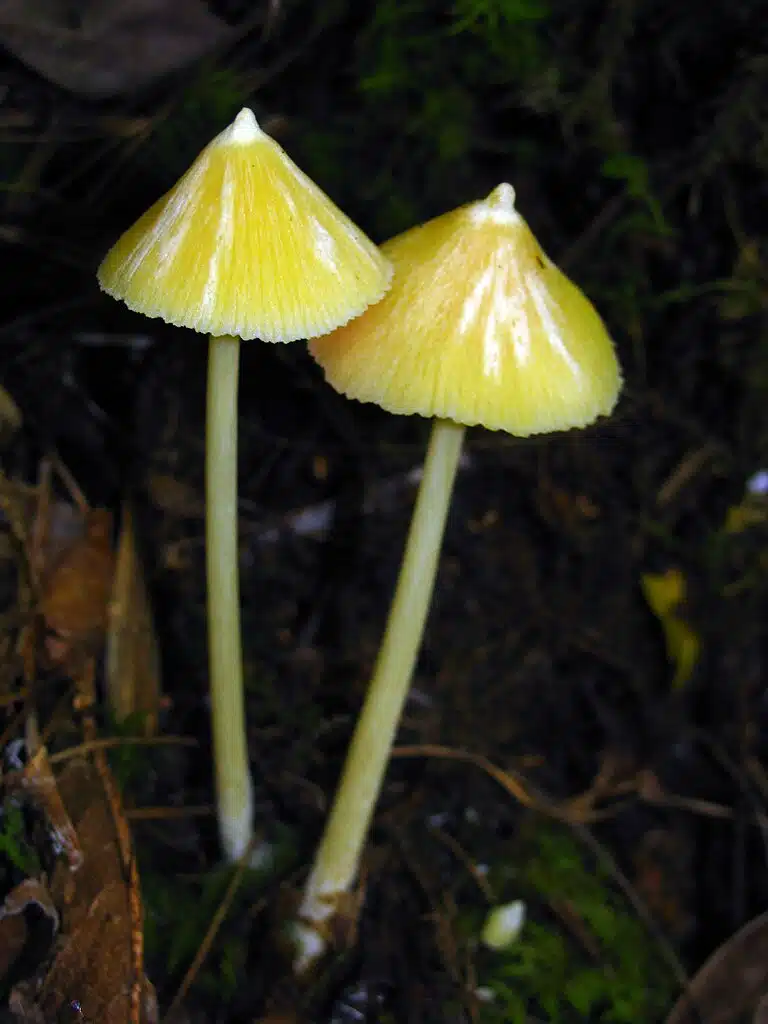
Scientific name: Entoloma murrayi
Common name: Yellow Unicorn
A very rare species, Yellow Unicorns are named after the bell-shaped cap of the species.
This is also one of the rare yellow mushrooms that maintains a bell-shaped cap throughout its growth stages.
Some of the wettest areas of woodlands are home to Yellow Unicorns, also native to North America.
Eastern parts of the United States are the places where these mushrooms grow. They prefer swamps and moss-covered areas of deep woodlands.
While bright, they are also small. Yellow Unicorn cap size varies considerably but is never larger than 1.1 inches in diameter.
A thin yellow stipe is also specific to the fungi which additionally show yellow gills.
Not much is known about the edible status of the species. Believed not to be edible, these mushrooms are too thin to even be worth picking.
The growing season can depend on the region of the species with slightly longer growth periods into late fall in its Central American regions.
37. Yellow Coral Mushroom
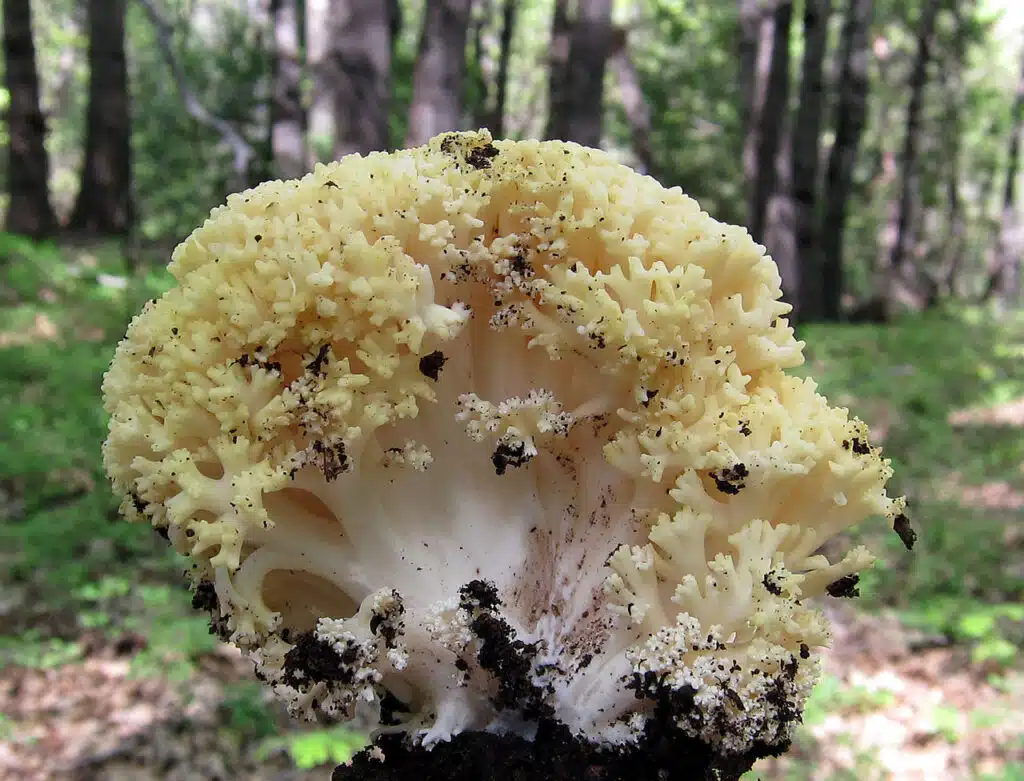
Scientific name: Ramaria rasilispora
Common name: Yellow Coral Mushroom
From Alaska to Mexico, Yellow Coral Mushrooms grow in the Western part of North and Central America.
These mushrooms have atypical fruiting bodies shaped like corals or like cauliflower.
They show pale yellow to white coloring and grow directly on the ground. While they don’t have a traditional cap and stipe, these mushrooms can also be tall, reaching a height of up to 5.9 inches.
Growing in moist grounds in the woodlands, these types of mushrooms have mixed reports when it comes to edibility.
About half of the sources available in The US state the species isn’t edible. Other sources, specifically in Mexico, state the species can even be eaten raw, mainly as part of a salad.
This is also one of the early-season mushrooms being one of the yellow mushrooms that grows in the spring.
38. Flaming Gold Bolete
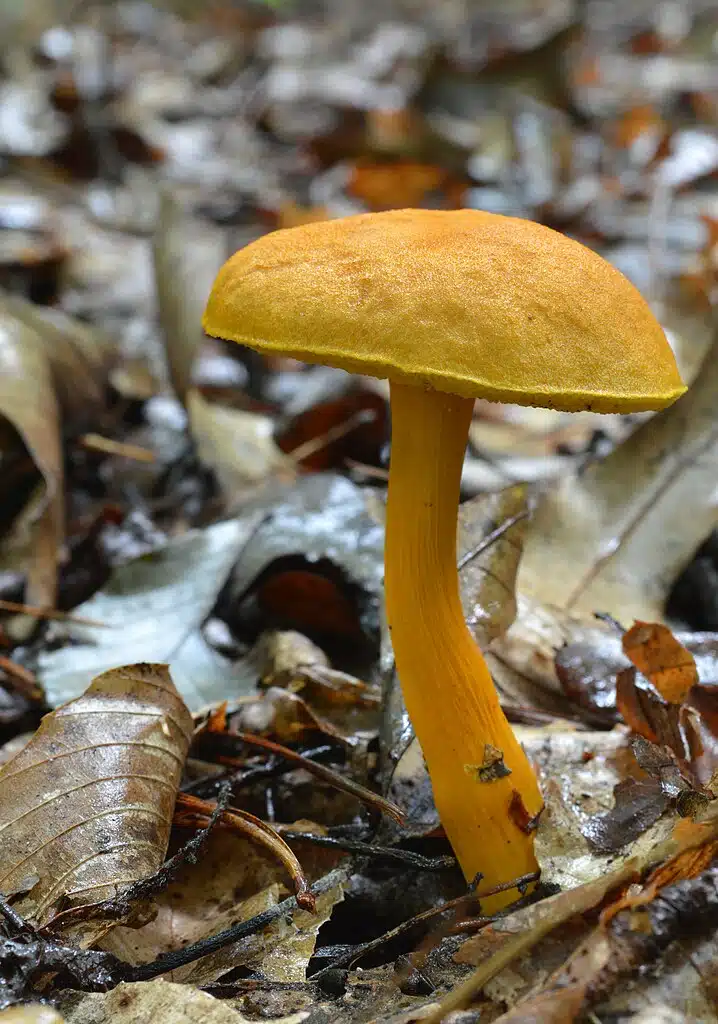
Scientific name: Aureoboletus auriflammeus
Common name: Flaming Gold Bolete
Flaming Golde Boletes are named after their intense golden nuance. These types of mushrooms are so colorful they even leave a yellow residue on the hands.
Mushrooms of this species have a yellow-golden nuance with a brown cap. Yellow sponge-like spores and stipe coloring complete their appearance.
A common presence in Eastern North America, Flaming Gold Boletes grow late into the season, up until November.
Found East of The Rocky Mountains, these mushrooms prefer oak woodlands and only grow under oak.
Flaming Gold Boletes also grow seldomly and can be found along the East Coast states in the highest numbers.
The species doesn’t bruise when cut and many expect it to be edible, just like many other boletes.
This isn’t the case as it has a rather unpleasant taste. Still, it’s not believed to be a species to cause an upset stomach in most cases.